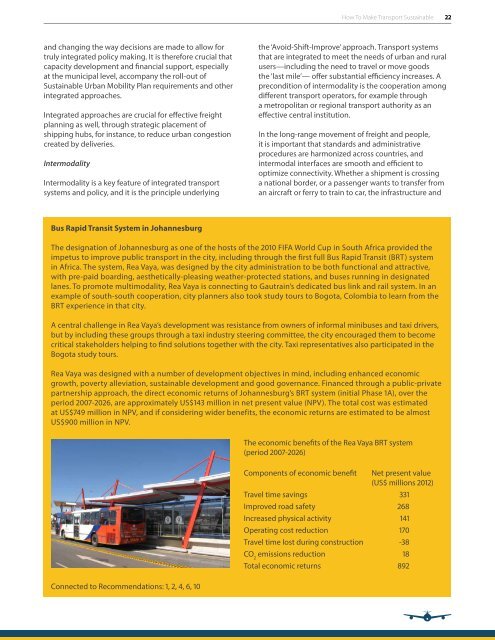MOBILIZING DEVELOPMENT
a5OQ306q56U
a5OQ306q56U
You also want an ePaper? Increase the reach of your titles
YUMPU automatically turns print PDFs into web optimized ePapers that Google loves.
How To Make Transport Sustainable 22<br />
and changing the way decisions are made to allow for<br />
truly integrated policy making. It is therefore crucial that<br />
capacity development and financial support, especially<br />
at the municipal level, accompany the roll-out of<br />
Sustainable Urban Mobility Plan requirements and other<br />
integrated approaches.<br />
Integrated approaches are crucial for effective freight<br />
planning as well, through strategic placement of<br />
shipping hubs, for instance, to reduce urban congestion<br />
created by deliveries.<br />
Intermodality<br />
Intermodality is a key feature of integrated transport<br />
systems and policy, and it is the principle underlying<br />
the ‘Avoid-Shift-Improve’ approach. Transport systems<br />
that are integrated to meet the needs of urban and rural<br />
users—including the need to travel or move goods<br />
the ‘last mile’— offer substantial efficiency increases. A<br />
precondition of intermodality is the cooperation among<br />
different transport operators, for example through<br />
a metropolitan or regional transport authority as an<br />
effective central institution.<br />
In the long-range movement of freight and people,<br />
it is important that standards and administrative<br />
procedures are harmonized across countries, and<br />
intermodal interfaces are smooth and efficient to<br />
optimize connectivity. Whether a shipment is crossing<br />
a national border, or a passenger wants to transfer from<br />
an aircraft or ferry to train to car, the infrastructure and<br />
Bus Rapid Transit System in Johannesburg<br />
The designation of Johannesburg as one of the hosts of the 2010 FIFA World Cup in South Africa provided the<br />
impetus to improve public transport in the city, including through the first full Bus Rapid Transit (BRT) system<br />
in Africa. The system, Rea Vaya, was designed by the city administration to be both functional and attractive,<br />
with pre-paid boarding, aesthetically-pleasing weather-protected stations, and buses running in designated<br />
lanes. To promote multimodality, Rea Vaya is connecting to Gautrain’s dedicated bus link and rail system. In an<br />
example of south-south cooperation, city planners also took study tours to Bogota, Colombia to learn from the<br />
BRT experience in that city.<br />
A central challenge in Rea Vaya’s development was resistance from owners of informal minibuses and taxi drivers,<br />
but by including these groups through a taxi industry steering committee, the city encouraged them to become<br />
critical stakeholders helping to find solutions together with the city. Taxi representatives also participated in the<br />
Bogota study tours.<br />
Rea Vaya was designed with a number of development objectives in mind, including enhanced economic<br />
growth, poverty alleviation, sustainable development and good governance. Financed through a public-private<br />
partnership approach, the direct economic returns of Johannesburg’s BRT system (initial Phase 1A), over the<br />
period 2007-2026, are approximately US$143 million in net present value (NPV). The total cost was estimated<br />
at US$749 million in NPV, and if considering wider benefits, the economic returns are estimated to be almost<br />
US$900 million in NPV.<br />
Connected to Recommendations: 1, 2, 4, 6, 10<br />
The economic benefits of the Rea Vaya BRT system<br />
(period 2007-2026)<br />
Components of economic benefit Net present value<br />
(US$ millions 2012)<br />
Travel time savings 331<br />
Improved road safety 268<br />
Increased physical activity 141<br />
Operating cost reduction 170<br />
Travel time lost during construction -38<br />
CO 2<br />
emissions reduction 18<br />
Total economic returns 892


